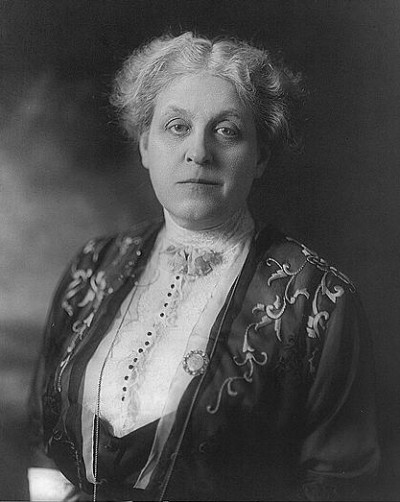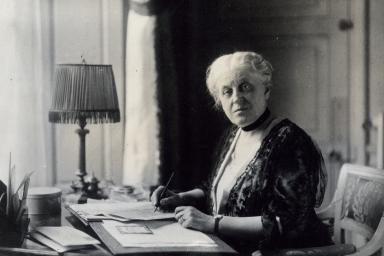Carrie Chapman Catt was a notable women’s suffragist. She campaigned heavily for the Nineteenth Amendment, which gave women the right to vote. She was also the National American Woman Suffrage Association’s president along with founding the League of Women Voters and the International Alliance of Women. Prior to her involvement in women’s rights, she taught at schools in Iowa.
On January 9, 1859, Carrie Clinton Lane was born in Ripon, Wisconsin to Lucius and Maria Louisa (Clinton) Lane. At seven years old, she and her family moved to Charles City, Iowa where Catt began her education. She took an interesting in science as a child and hoped to become a doctor.
Catt enrolled at Iowa State Agriculture College (today it is known as Iowa State University), located in Ames, Iowa. Originally, her father was hesitant to let his daughter go to college, but eventually gave in. He only paid a portion of the expenses. So to pay for the rest of the costs, Catt worked various jobs, such as in the school library, a dishwasher, and a teacher whenever she was off of school. She was a member of a student organization to dancing self confidence and learning skills among the students called the Crescent Literary Society. At the time, the only people permitted to speak at meetings were men. But Catt shoved aside the rules, speaking up during a male debate that sparked up a conversation in the group. Among other things, Catt started an all girls’ debate club and began advocating for female participation in military drills. She was a member of Pi Beta Phi, an international Fraternity for Women.
Three years later, Catt graduated as valedictorian with a Bachelor of Science degree on November 10, 1880. She was also the only female in her graduating class, though during her freshman year she was one of six women.
Following her graduation, Catt worked as a law clerk for some time before becoming a teacher. In 1885, she became superintendent of schools located in Mason City, Iowa, the first female to be the district’s superintendent.
That February (1885), Carrie Clinton Lane married Leo Chapman, becoming Carrie Chapman. However, Leo died not long after in August of 1886 while in California due to typhoid fever. She decided to remain in San Francisco as the first female reporter in the city. A few years later, Carrie Chapman married George Catt in 1890. George Catt was a wealthy engineer who was also a previous student at Iowa State University. He was the one to encourage her to really become involved in women’s suffrage. In the late 1880s she became involved in suffrage. With their marriage, Carrie Catt could spend most of the year campaigning for the cause.
Upon returning home to Charles City in 1887, Catt found herself becoming involved in the Iowa Woman Suffrage Association. For two years from 1890-92, she also served as the state organizer for the Iowa Association. During this time, Catt also started to work on a national level for suffrage. She worked for the National American Woman Suffrage Association (NAWSA). In 1890, Catt was even a speaker at NAWSA’s Washington D.C. convention. Two years later in 1892, Susan B. Anthony asked Catt to address Congress to speak of the new woman’s suffrage amendment that had been proposed. Anthony, who was President of NAWSA, would later on be succeeded by Catt.
Catt’s first term elected to president of NAWSA was from 1900-04. She had to resign during her first term though because her husband’s health was failing. In 1915, she became president again. This time though, NAWSA had become terribly divided under Anna Howard Shaw’s leadership. Catt was able to increase not only the size of the organization, but also the funds. In 1916, the NAWSA convention was being held in Atlantic City, New Jersey. There, Catt revealed what she called her “Winning Plan”. The goal was to hopefully obtain suffrage in state levels and then on a federal level. For the states who resisted change, Catt made sure to promise partial suffrage. And also under Catt’s leadership, NAWSA once again won back support of the U.S. Congress and various states for the amendment to be ratified. In 1917, Catt successfully campaigned for suffrage in New York, a state that had previously been against it. When the U.S. entered the Great War that same year, Catt decided to support the war.
On August 26, 1920, the Nineteenth Amendment to the U.S. Constitution was finally approved after Catt and other NAWSA members spent countless hours lobbying for support.
After retiring as president of NAWSA, Catt still continued working in suffrage. Shortly after George Catt’s death in 1805, Carrie Catt started working with the International Women’s Suffrage Alliance, serving as its president from 1904-23.. In 1920, she founded an organization to try and encourage women to use their new rights and vote called the League of Women Voters. For the rest of her life, she was the organization’s honorary president. Catt also ran for president of the Georgist Commonwealth Land Party and published Women Suffrage and Politics: The Inner Story of the Suffrage Movement with Nettie Rogers Shuler.
Once the Nineteenth Amendment was passed, Catt had gone back to working with the peace movement. She cofounded an organization with a few others called the National Committee on the Cause of Cure of War (NCCCW). The organization, which was made up of wem, believed that as women, their jobs were to end wars. This was because women were seen as more morally courageous than men, who were more physically courageous.
Catt resigned from the NCCCW because it did not go how she had planned during World War II. Instead of including all women like she wanted, it really only included white middle-class women. Catt then organized the Committee of Non-Jewish Women Against the Persecution of Jews in Germany in response to Hitler in 1933. That August the group got 9,000 signatures from non-Jewish American women and sent a protest letter to Hitler. Catt also pressured the government to make emigration laws easier for Jews coming to take refuge in the U.S. She was also the first woman to receive the American Hebrew Medal for her efforts during the war.
The final event Catt took part in planning was in 1940: the Women’s Centennial Congress in New York. The event was to celebrate feminism in the U.S.
Carrie Chapman Catt died of a heart attack on March 9, 1947 in New Rochelle, New York. She was buried beside her Mary Garrett Hay, her logntime companion she had been living with for over twenty years, at Woodlawn Cemetery in New York City.



